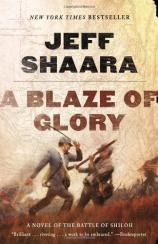A Blaze of Glory: A Novel of the Battle of Shiloh
Review
A Blaze of Glory: A Novel of the Battle of Shiloh
As 1862 takes hold of the calendar, the Confederate forces are faring none too well in the Western Theater. General Ulysses S. Grant has led Union forces in successful assaults on Forts Henry and Donelson, the first two significant victories for the Union. Confederate soldiers under the command of Albert Sidney Johnston flee the Forts and run deeper south, yielding the city of Nashville to the oncoming Union army. Most of Tennessee is now in possession of the northern aggressors.
"A BLAZE OF GLORY is a riveting installment in Shaara's historical fiction catalog. Once more, the depth of his knowledge and research about the combat and its related soldiers is unparalleled."
As A BLAZE OF GLORY opens, we see General Johnston attempting to hold together his forces and secure a retreat by having his cavalry, led by Colonel Nathan Bedford Forrest, hold the Union at bay for as long as practicable. He needed to unify his forces with those of General P.G.T. Beauregard, who was massing troops in Corinth, Mississippi. The Rebels were fairly broken and struggling to hold together, making them a perfect target for advancing Union forces.
Luckily for them, General Halleck was more concerned with looking good for the papers and making sure his reputation with higher-ups out East was in good standing. He squabbled with those who reported to him and tended to punish those who found more success and made better names for themselves. One of his great targets was Grant. With General George Tecumseh Sherman by his side, Grant drove his men downriver and settled into camp at Pittsburg Landing. He was to wait there for reinforcement from Buell, and once united, they would strike down in pursuit of Johnston. Buell was slow in coming.
On April 6th, Johnston and Beauregard led a surprise assault on Grant's army at dawn. Grant was not present, however, having been wounded two days earlier when his horse fell on him. Instead, General Sherman was in charge and had not anticipated an attack. The unsuspecting soldiers were forced back against the Tennessee River. A sunken road that became known as the Hornet's Nest provided the Union commanders with enough time to establish a viable counterstrike and lay defenses. The horrible fighting of the Hornet's Nest was both a success and a loss for each side: the Union troops bought time but lost over 2,000 men as prisoners to the Confederates. The rebels won that ground but were devastated when their commander, General Johnston, was mortally wounded; he would be the highest ranking soldier on either side to die during the war. Beauregard took command and continued to strike at Grant and Sherman, but he could not break them. Both sides settled in for the night and prepared for the next day's conflict. Beauregard had no real sense for the battle lines and was unaware that, as the night wore on, Buell had arrived with reinforcements for Grant. Upon waking, Beauregard was unknowingly outnumbered.
The battle of the second day was no less fierce than before, and the reconstituted Union force continued to drive and pummel Beauregard's lines, pushing them to retreat back to the old Shiloh Church. There, Beauregard would hold the Union for a time, but as evening came on, they would begin to fall back to Corinth. Grant and Buell would argue over whether to pursue the Confederates, but Grant stated that his tired men would not march. He sent a force with Sherman the next morning to move toward Corinth. In an area known as Fallen Timbers, Sherman encountered Nathan Bedford Forrest. The great Confederate Cavalry leader would be severely wounded by a shot to the hip, but he would still escape with his men.
Grant would be vilified by the media for the loss of life and poor performance on the first day of battle. Rumors would swirl that he was drunk. Lincoln refused to remove Grant, but Halleck would demote him for a time. Sherman, who had recently come back to the fighting after a sabbatical for mental issues, proved his worth in remarkable fashion. Their ability to work together as a cohesive unit would bring further victories for the Union as the days and years wore on.
It is here, in the grim killing fields of Shiloh, that Jeff Shaara brings us back into the Civil War, and he does it will all the exquisite skill one has become accustomed to when picking up a volume of his work. A BLAZE OF GLORY is a riveting installment in Shaara's historical fiction catalog. Once more, the depth of his knowledge and research about the combat and its related soldiers is unparalleled.
The main leaders are brought out as fascinating, living actors on this bloody stage; Grant, chewing on his cigars, his tactical mind showing its under-appreciated skill and the fiery drive of Nathan Bedford Forrest as he contemplates the best way to destroy the north. The most impressive, however, is George Tecumseh Sherman. Shaara is masterful at showing the Union General and his nervous, paranoid nature, seeing the enemy behind every shadow and fearful of ambush. All of this will fade as the hellfire of battle erupts, and he must take charge of the lines, putting himself amongst his men to urge them and inspire them.
Shiloh, to this point of the war, is the bloodiest battle in American history with over 23,000 killed or wounded. While A BLAZE OF GLORY excels with the presentation of the military minds behind the strategy, it surpasses an already high plateau as we are introduced to the simple men called to fight on behalf of their warring nations. These fictional representations settle the reader into the very heart of the conflict and bear witness to the true horrors described, as the Hornet's Nest is assaulted and men fall fast and furious in the Peach Orchard as blossoms rain down from the trees during the firefight.
Shaara isn't here to lay out every fact and detail of Bloody Shiloh. In fact, in his introduction, he advises those seeking to get the numbers and tactics right down to the last detail to read books by prominent historians. His purpose is to present the battle with a scintillating amalgamation of fact and a dose of fiction. The results in this case are brilliant.
The title of the book is drawn from a quote from James A. Garfield, a Union General and future President, and presented in the opening pages: The horrible sights that I have witnessed on this field I can never describe. No blaze of glory, that flashes around the magnificent triumphs of war, can ever atone for the unwritten and unutterable horrors of the scene of carnage.
We will never fully understand nor be able to wholly comprehend the savage and horrific scenes that unfolded on the land surrounding the old Shiloh church. But Shaara has transported the reader onto that drenched field, leaving them shivering in the night following the first exchange of fire and listening to the wounded and the dying crying out as the rains come down again, men weary from long marches, sickness and war. It is not too difficult to smell the wet wood, marvel at the drifting peach blossoms as the trees are torn apart, or feel the weight of a broken nation as its sons fall in numbers too great to justify. These things all emerge from the dust of history because of the deft writing of Shaara, which makes A BLAZE OF GLORY a work to be embraced.
Reviewed by Stephen Hubbard on June 1, 2012
A Blaze of Glory: A Novel of the Battle of Shiloh
- Publication Date: April 9, 2013
- Genres: Fiction, Historical Fiction
- Paperback: 480 pages
- Publisher: Ballantine Books
- ISBN-10: 0345527364
- ISBN-13: 9780345527363





